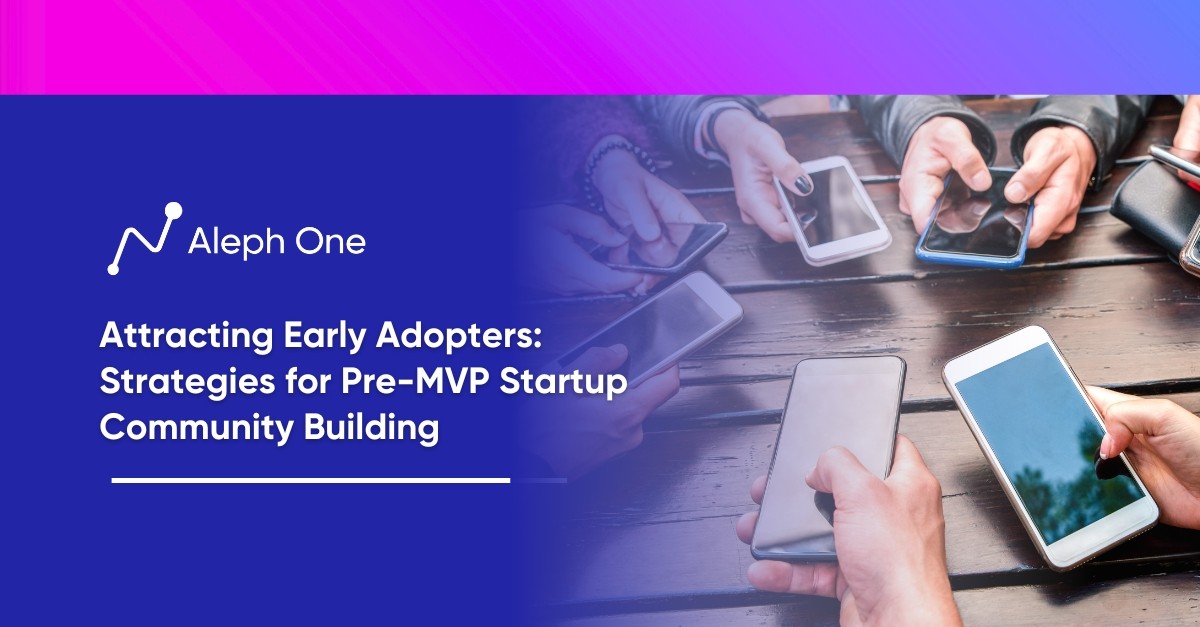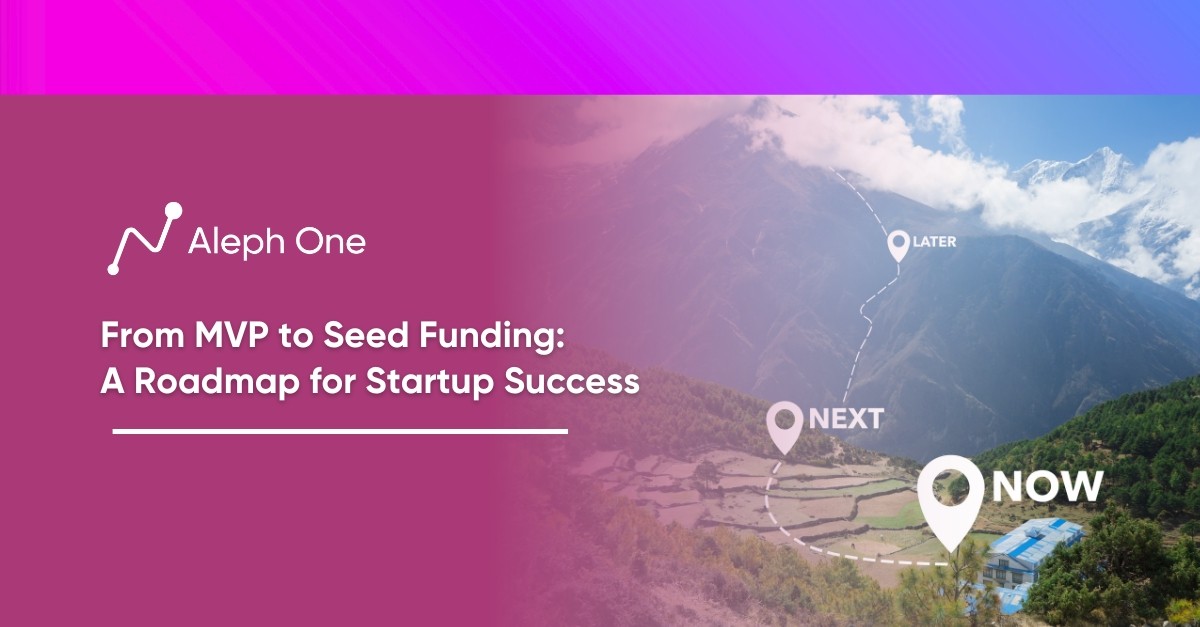Let’s work together to build something amazing. Share your project details and our team will reply to figure out the next steps to your success.

In a cutthroat business world where startups vie for survival, one strategy has emerged as a game-changer: the minimum viable product (MVP). This approach allows entrepreneurs to test their ideas, adapt swiftly, and unlock the path to seed funding and beyond. In this article, we dive deep into the world of MVPs, uncovering their importance in today’s competitive market. From the rise of the lean startup methodology to real-life success stories, growth hacking techniques, and the ultimate journey from MVP to securing crucial funding, get ready to embark on a thrilling ride that reveals the secret behind entrepreneurial triumphs.

The Rise of the Lean Startup: How MVPs Emerged
The lean startup methodology has emerged as a popular alternative to traditional business planning in recent years. The core principles of the lean startup involve developing a minimum viable product (MVP), testing assumptions, adapting based on feedback, and iterating rapidly. This approach arose in response to the notoriously high failure rates of startups. According to research from CB Insights, the top reasons for startup failure include a lack of market need (42%), running out of cash (29%), and being outcompeted (19%).
The History of the Lean Startup Method
The lean startup method was pioneered by entrepreneurs like Steve Blank and popularized by Eric Ries in his bestselling book The Lean Startup. They argued that startups are not smaller versions of large companies. Startups operate with high uncertainty and scarce resources, requiring a different approach to business planning and product development.
MVP Allows for Quicker Release & Sustainable Business Model
Rather than creating a business plan and product roadmap upfront, the lean startup method focuses on releasing a minimum viable product (MVP) as quickly as possible to test key ideas. An MVP is usable by early customers, who can provide feedback to validate or invalidate the startup vision. By adapting to customer feedback, startups can “pivot” as needed to find a sustainable business model.
This MVP-centered approach allows startups to operate with agility and “fail fast” until they achieve product-market fit. Startups that achieve fit can then scale their business, having already developed a customer base and learned how to build a solution that addresses a real market need. In contrast, startups that spend years perfecting a product in isolation often need help to gain traction. The lean startup method acknowledges startups need to get out of the building to develop solutions customers want.
MVP 101: What You Need to Know
An MVP, or minimum viable product, is a core concept in the lean startup methodology. An MVP is a basic first version of a product that allows a startup to collect the maximum amount of learning about customers with the least effort. The goal of an MVP is not to be a finished product but rather to test key assumptions about a product and business model.
What are the Characteristics of an MVP?
Some key characteristics of an MVP include:
- Focus on learning: The primary goal of an MVP is to learn, not to scale or generate profits. It allows startups to gather customer interest, needs, and behavior data.
- Minimize waste: An MVP avoids wasted time and effort building features that customers do not want. It takes an iterative approach to product development based on feedback.
- Speed: An MVP gets a basic product in front of customers as quickly as possible. This allows for faster learning and the ability to adapt to change.
What Are Different Types of MVPs?
There are several forms an MVP can take:
- Landing page MVP: A basic landing page that describes the product concept and allows customers to express interest by providing contact information. This tests demand and customer interest.
- Explainer video MVP: A video that demonstrates how the product concept works and solves a customer problem. Viewers can again provide contact information if interested.
- Crowdfunding campaign MVP: Running a campaign to pre-sell a product concept on a platform like Kickstarter or Indiegogo. Success shows customer interest and demand.
- Prototype or beta MVP: Developing a very basic first working product version for a small set of customers. Feedback is collected and used to improve the product.
The core benefits of an MVP approach are reduced risk, faster learning, and adaptability. Startups avoid wasting resources on products no one wants and can quickly pivot based on customer feedback. Studies show that over 70% of startups change their initial product concept significantly. An MVP allows them to do so efficiently and maximize their chances of success.
Case Studies: How Startups Hacked Their Way to Success With MVPs
Some of the most successful startups of the past decade launched with a minimum viable product, learned from early users, and adapted to build billion-dollar businesses. Dropbox, Airbnb, and others started with very basic first versions of their products before improving and expanding based on user feedback.
Dropbox – File Sharing Service
Dropbox began as a simple file-sharing service. Founder Drew Houston built the first version in a few hours, focusing on the core functionality of uploading and sharing files. This MVP attracted initial users and interest from investors, allowing Dropbox to raise seed funding. From there, Dropbox enhanced the product based on user feedback, adding features like syncing across devices and file recovery. Today, Dropbox has over 600 million users and a $10 billion valuation.
Airbnb – Airmatteresses and Couches
Airbnb launched AirBedandBreakfast.com, a basic website for renting air mattresses and couches. In days, Founders Brian Chesky and Joe Gebbia put together the original MVP to test their assumption that people would pay to stay in others’ homes. The co-founders went door-to-door in New York City, taking photos of rentals and building the website. This low-fidelity MVP attracted interest from initial users and investors, allowing Airbnb to get off the ground. Airbnb now offers millions of places to stay in over 190 countries, with a $31 billion valuation.
These startups and many others have proved that a well-executed MVP can be enough to build a successful business. However, it requires continuously improving and adapting to user feedback. An MVP is about something other than creating a poor user experience or a shoddy product. But by starting small, monitoring how people use the product, and making changes accordingly, startups can achieve the kind of success previously only possible for large companies with huge development budgets. With an MVP, startups have the flexibility and speed to pivot as needed to create products that users genuinely want and value.
The Dangers of MVPs: Challenges to Avoid
While the MVP approach offers many benefits, it also comes with risks and downsides that startups should be aware of. One danger is providing a poor user experience. An MVP is meant to be a basic first version of a product, but that does not excuse a sloppy or frustrating user experience. If an MVP is too barebones or buggy, it may turn off users and damage the brand before getting off the ground.
Lack of Interest from Customers or Investors
While an MVP aims to validate demand, an idea may not resonate with target users or funders. Startups should ensure signals indicate their solution addresses a real problem before devoting too many resources to an MVP. If interest seems low, it may make sense to reevaluate the concept, make significant changes, or start over with a new idea.
Pivot Paralysis
A further challenge is “pivot paralysis,” the tendency to make constant changes without progress. While adapting based on feedback is vital, startups can get stuck endlessly tweaking their MVP without moving forward. There comes a point where you have to determine an MVP is good enough to build upon, rather than repeatedly revamping it. Startups should have concrete goals and milestones to work toward to avoid being perpetually stuck in the MVP phase.
How to Avoid MVP Pivot Paralysis
To address these issues, startups must execute their MVP thoughtfully and strategically. A poorly designed MVP should not be an excuse to release a subpar product. Founders must also go into the MVP process with eyes open to the possibility that an idea may not resonate and be willing to make hard choices if interest is lacking. Having a plan to build upon an MVP and clear metrics for progress can help avoid the “pivot paralysis” trap. With careful planning and management, startups can leverage the power of MVPs while navigating challenges. The key is finding the right balance between adapting based on feedback and pushing forward decisively toward your ultimate vision.
Growth Hacking: How to Build a User Base
An MVP is only valuable if real customers use it and provide feedback. Growth hacking refers to startups’ creative strategies to gain traction and build their user base. While an MVP focuses on learning, growth hacking focuses on scaling. When combined with an MVP approach, growth hacking techniques can help startups gain momentum and achieve seed funding.
Social Sharing
One of the most effective growth hacking strategies is social sharing. Startups should make it easy for users to share their products or service on social media platforms like Twitter, Facebook, and LinkedIn. Adding social sharing buttons, offering referral incentives, and creating shareable content are ways to boost social sharing.
Email Marketing
Email marketing is another important growth channel. Startups should capture email addresses from all website visitors and work to build a regular email newsletter. Email newsletters, when done well, have high open and click-through rates.
Search Engine Optimization (SEO)
Search engine optimization (SEO) involves optimizing web content to rank higher in search engine results pages. Higher rankings equal more traffic and growth. Startups can implement technical, on-page, off-page SEO strategies to improve search visibility and drive more organic traffic. Partnerships with influencers who have a large following are also effective. Influencers can promote the startup’s product to their audience, creating new signups and increased buzz.
Avoiding Wasted Time
Growth hacking helps minimize wasted time and resources by taking an iterative approach to building a user base. Startups can implement a technique, analyze the results, then make changes before moving on to the next strategy. Not all strategies will work, so adapting based on data is key.
With a small amount of funding and effort, growth hacking techniques can yield a high ROI. They represent a way for resource-strapped startups to gain significant traction and prove the viability of an MVP. Growth is one of the most critical milestones for investors, so startups that can hack their way to substantial user growth will be in a good position to achieve seed funding.
From MVP to Funding and Beyond
Once you have developed an MVP and begun to gain user traction through growth hacking techniques, the next step is to secure seed funding to scale your business. Investors will be looking to see how you have progressed from your initial MVP—what you have learned, how you have adapted, and key metrics around customer acquisition and retention. They want to see a roadmap for how funding will be used to grow the business to the next level.
How to Raise Seed Funding
To raise a seed round, you must have clear data showing your key milestones and metrics. This includes total users, daily or monthly active users, user growth rate, conversion rates, customer lifetime value, customer acquisition cost, and churn rate. You need to demonstrate how these metrics are trending in a positive direction. Investors also want to see that you have a viable business model that can generate revenue and profits over time.
How to Determine if the Timing Is Right for Seed Funding
With this data and model, you must determine if the timing is right for seed funding. There is no set formula, but if you have a few thousand highly engaged users and are ready to scale, you may be in a good position. You must also consider having enough traction and metrics to achieve a reasonable valuation. It is often better to wait until you have optimal metrics and leverage than raise funding from a position of weakness.
Prepare a Pitch Deck
When you are ready to raise a seed round, prepare a pitch deck summarizing your business plan, product, team, financials, key milestones achieved, and how you will use the funding to accelerate growth. You should target seed funds, angel investors, and venture capital firms focusing on early-stage startups. With a compelling story and strong metrics, you can raise $250K-$2M or more in seed funding.
Grow and Fund Your Startup With an MVP
From there, you can use the funding to scale your operations, improve your product, expand your marketing and sales efforts, and work toward a Series A round. Continually optimizing based on user feedback and growth metrics will be crucial to your long-term success. With the right focus and execution, a seed-stage startup can go on to become a high-growth business.
How does a startup minimize the risk of "pivot paralysis" in the MVP phase and move forward to building a sustainable business model?
Startups can minimize the risk of “pivot paralysis” by setting clear, measurable objectives for each iteration of their MVP. This involves defining specific milestones and key performance indicators (KPIs) that signal readiness to move from the MVP phase to scaling the business. By focusing on fulfilling these set targets, startups can avoid the trap of constantly tweaking the MVP without substantial progress. They should gather and analyze feedback from each MVP iteration and make decisive changes aligning with their vision. Regular team revisits of goals, product-market alignment, and achieved milestones help ensure forward movement.
What are some comprehensive examples of successful growth hacking techniques implemented by startups to build their user base?
Successful growth hacking techniques vary based on the startups’ target audience, business model, and industry. One great example is Dropbox, which implemented a referral program offering extra storage space for the referrer and referee. This strategy tapped the human tendency for reciprocity, leading to a 60% increase in their daily sign-ups. Airbnb seamlessly integrated with Craigslist, gaining them access to a significantly larger user base. PayPal offered cash rewards for new account sign-ups, leading to exponential user growth. A common thread in these examples is a deep understanding of their target audience, leveraged to create strategies that encourage user engagement, retention, and organic expansion.
In what way can startups effectively present their key milestones and metrics to attract seed funding?
To attract seed funding, startups must clearly present their key milestones and metrics to potential investors concisely and compellingly. This includes metrics such as total active users, growth rate, churn rate, and customer acquisition cost. Documenting and sharing how these metrics have improved over time is important, showcasing positive trends. Furthermore, startups should share lessons learned from customer feedback and changes made to the MVP and business plan in response. Case studies of successful customer engagement and a detailed plan on how the seed funding will be used to drive growth would give investors confidence in the team’s vision and execution capability.
Get the latest news and updates from Aleph One in your inbox.



